


FREQUENTLY ASKED QUESTIONS
The Department of Business and Professional Regulation is very strict on protecting Florida consumers and they not only ensure you can check any license for free, but also make sure it is up to date with continued education and insurance.
To view original law text click here: -------------------- To verify a current license, click here:
No, since 2011, Florida legislation has it made it illegal to simply be certified as a mold assessor (or property inspector), only a state licensed mold assessor is approved. It is, however, possible to obtain additional certifications besides the state license, but it is never acceptable to have only a certification.
Yes, we are! We are one of the very few mold and thermography inspection businesses truly accredited with the BBB. Some companies falsely have the BBB logo on their website, however, once you check with the BBB, you discover that is simply not true.
It is important for us to show all our residential and commercial clients we stand by behind our two company mottos:
Romans 12:17 Do Things In Such A Way That Everyone Can See You Are Honorable.
And
Creating Safer Living Through Quality Inspections
This can vary depending on what type of inspection and what type of lab samples were requested. We utilize several accredited laboratories, all of which provide fast turnaround time.
Typically, reports and lab reports are provided with 24-48 hours after inspection, however, for rush jobs or medically-sensitive projects, the labs can also offer same day for an additional service fee.
Great question, and yes, we absolutely do. In fact, we are often recommended by them as a first step to help identify the problems and to produce a proven protocol plan. If you are already working with them, then with your permission, we will coordinate testing and plan with them as well. We want to ensure everything is done as smoothly as possible for you.
For an initial inspection, it is preferable you are home to help identify what areas are of concern. We recognize that it’s not always possible with work and family schedules, and an adult family or friend can also provide access.
For mold clearance verification tests, no one needs to be home, access can often be provided via lock box.
There is no program where the government will pay for the inspection or testing, this part must be done by the renter. That said, once you have a report and if it shows elevated or toxic mold, then the landlord must ensure the mold is removed. If the landlord does not take steps to remove it, then you can contact your local city or Florida state for them to take legal action.
At StoneCrest Team we offer several types of inspections to accommodate issues such as this.
If the tenant has a mold report that shows elevated or toxic mold spores, then a mold remediation company must be hired. Following the remediation, StoneCrest Team will conduct a clearance test to verify the work was done and that your property is now clear of mold.
If the tenant did not have a mold test, then you must schedule one quickly to determine what the actual condition of the properly is. This will assure the tenant that you are concerned about their health and want to address the situation. It further protects your property and investment from a potential ongoing mold issue and any potential legal action.
Yes! 😊 We take pride in actually helping you interpret the results of the laboratory mold analysis and provide a comprehensive mold report accepted by insurance companies, medical professionals, and legal teams. The terms Stachybotrys, Penicillium, Aspergillus, Cladosporium, and spores per cubic meter probably mean little to you. However, each tell us volumes about what is happening in the property and we will explain it patiently and in layman terms for everyone to understand.
General Questions
Many people suffering from chronic respiratory infections are not aware that their problem is often related to mold exposure. And unfortunately, their physicians are also unaware, making appropriate treatment impossible.
All molds have the potential to cause ill health, depending on their type, whether or not they produce toxins, how long you are exposed, and your overall health and resistance to infection.
Besides minor or major respiratory problems, molds can also cause a multitude of other problems, including skin rashes, gastrointestinal problems, genitourinary problems, immunosuppression, and hemorrhage.
According to the Environmental Protection Agency (EPA), all molds have the potential to cause ill health. The type and severity of your symptoms depend, in part, on the types of mold present, the extent of your exposure, your age and general health, and your existing sensitivities or allergies.
At a 2003 environmental medicine symposium in Dallas, studies of more than 1,600 patients suffering health issues related to fungal exposure were presented. These patients experienced major medical problems, including:
Muscle and joint pain
Headache, anxiety, depression, memory loss, and visual disturbances
Immune system disturbances and fatigue
GI problems
Shortness of breath
Many of the symptoms related to mold resembles that of a common cold or allergy condition. Therefore, often times the appropriate diagnoses goes undetected. However, many common symptoms that are associated with toxic mold and mold exposure are:
Mental and Neurological Symptoms From Toxic Black Mold
The trichothecene mycotoxins produced by toxic black mold are neurotoxic. This means they can kill neurons in the brain and impair a person's mental ability. They also cause nervous disorders such as tremors and can cause personality changes such as mood swings and irritability. Symptoms:
Confusion
Brain fog
Shortened attention span
Difficulty concentrating and paying attention
Slowed reflexes
Disorientation
Dizziness
Memory loss and memory problems
Impaired learning ability
Hallucinations
Shock
Anxiety
Depression
Aggression and other personality changes
Tingling
Trembling
Shaking
Seizure
Numbness
Respiratory Symptoms From Toxic Black Mold
People living in homes with toxic black mold are exposed mainly through breathing in toxic black mold spores and mycotoxins. Toxic black mold mycotoxins create irritation and a burning feeling in a person's air passages such as the nasal cavity, mouth and throat. The mycotoxins can even become lodged in the mucus membranes, sinuses and the lungs which then causes a burning feeling, breathing problems and bleeding in the lungs. Symptoms:
Difficulty breathing - breathlessness or shortness of breath
Wheezing
Coughing
Pulmonary edema - swelling of the lungs
Pulmonary hemorrhage - bleeding in the lungs
Sore throat
Burning sensation of the mouth
Bleeding gums
Runny nose
Itchy nose
Stuffy, blocked nose
Nose bleeds
Circulatory Symptoms From Toxic Black Mold
Toxic black mold mycotoxins can be breathed in, ingested, or absorbed through a person's skin or eyes. Eventually the mycotoxins then find their way into the person's blood which can lead to heart damage, problems with blood clotting and internal or external hemorrhaging. Symptoms:
Irregular heartbeat
Heart inflammation
Damage to heart
Low blood pressure
Bone marrow disruption
Bleeding tendency
Blood not clotting properly
Hemorrhage - internal bleeding
Vomiting up blood
Vision and Eye Symptoms From Toxic Black Mold
Toxic black mold mycotoxins that are in the air can enter a person's eyes. The mycotoxins are cytotoxic (toxic to cells) and when they come into contact with eye cells they can cause inflamed and injured eyes and create vision problems. Symptoms:
Eye inflammation and soreness
Red or bloodshot eyes
Eye damage
Blurry vision and vision worsening
Jaundice (yellowing of the eyes)
Skin Symptoms From Toxic Black Mold
Through the skin is one of the three main ways that toxic black mold mycotoxins enter the human body. There have been cases in the past where people have handled hay contaminated with toxic black mold and developed severe rashes and skin problems on their body where they touched the hay, as well as on sweaty areas like the armpits. Symptoms:
Sensitive skin
Dry skin
Crawling skin
Dermatitis - skin inflammation, rash, blisters, itchiness
Jaundice (yellowing of the skin)
Immune System Symptoms From Toxic Black Mold
Toxic black mold puts out chemicals which can suppress the immune system. In fact many immunosuppressive drugs are actually created from toxic molds. A person who is immunocompromised from being around toxic black mold will more easily get infections and sicknesses. Symptoms:
Immunosuppression - immune system not functioning properly
Infections reoccurring
Tiredness and Discomfort Symptoms From Toxic Black Mold
When a person is around toxic black mold the immune system may release a sedative called Chloral Hydrate. This is used as a defense to try to slow down the effects of toxic black mold. But this also makes a person tired and causes fatigue. Toxic black mold can also cause soreness of the muscles and joints. Symptoms:
Chronic fatigue
Drowsiness
Weakness
Aches and pains
Muscle pain
Chest pain
Abdominal pain
Joint pain
Malaise - general discomfort
Headaches
Cold or flu type symptoms or recurring colds
Fever
Nausea
Vomiting
Diarrhea
Mold & Health Questions
Black Mold & Toxic Mold
Stachybotrys chartarum, also known as black mold, is one of the most infamous and toxic molds that can be found in homes. There are actually several mold species that are toxic, but most are lumped together as black mold and the most well-known species is Stachybotrys.
Black mold is highly toxic because it produces toxins called mycotoxins.
Given the proper conditions, black mold spreads quickly. People are sometimes not even aware that their homes are contaminated with black mold until there is either visible fungus or they are not feeling well.
Black mold is a serious concern for the majority of homeowners, primarily because it thrives in everyday conditions. The speed at which black mold spreads and the extent of damage it does to your property depends on how quickly you act to get it tested. Mold can become a problem before any major evidence is visible, but by recognizing the hints you can prevent it from spreading.
Not quite. As noted above, there can be different species called black mold, but the color ranges from light greyish to the extreme black. Because of this variance many people mistakenly think they do not have toxic mold as they cannot see it. Sadly, they are surprised when the tests come back positive for toxic mold.
The environmental risk of toxic mold may be one of the next major real estate “due diligence” concerns, especially for residential and commercial properties that have had water releases due to plumbing failures, condensation, and water leaks, as well as locations in past flood areas.
One major concern is the permanent elimination of the entire toxic mold from the structure. Incidents of future reoccurrence of Stachbotrys, a common form of toxic mold, are disturbingly frequent. Therefore, great care must be exercised to remove and dispose of any products contaminated by the toxic mold – a recommendation supported by many state Departments of Health.
Another concern is that people react differently to toxic mold exposure. Certain individuals, especially children, exhibit severe reactions which include damage to lung tissue, memory loss, and even death. Other persons exhibit less severe symptoms and fewer long-term consequences when exposed. The severity of symptoms and effects may depend on the individual’s chemical sensitivity, genetic disposition and health history (allergies, asthma, smoking, etc.).
For some, the exposure to the toxic mold spores may be classified as a “health risk”, while it is a true “health hazard” (potential for loss of life or quality of life) for others.
There have been numerous major lawsuits concerning toxic mold exposure in residential and commercial buildings throughout the United States. Currently, most health organizations consider exposure to Stachybotrys mold a health hazard. Additionally, most responses leading to testing, investigation, and abatement of the Stachybotrys toxic mold result from occupant complaints or documented negative health effects. The increasing concern over Stachybotrys mold may evolve to a point where it is regarded with the same precautions, responses and liability concerns as lead-based paint and asbestos.
Molds produce a number of powerful substances that can affect your health in beneficial or detrimental ways. Not surprisingly, fungi produce potent biologically active compounds—after all, lysergic acid (the parent compound of LSD) is produced by a mushroom. And penicillin is a mycotoxin produced by the mold Penicillium, better known as an antibiotic.
Some mold compounds are volatile and released directly into the air, known as microbial volatile organic compounds (mVOCs).7 Fragments of the cell walls of molds (glucans) can also be inhaled and cause inflammatory respiratory reactions, including a flu-like illness called Organic Dust Toxic Syndrome (ODTS).
But the most serious danger comes from highly poisonous agents called mycotoxins.
More than 200 mycotoxins have been identified from common molds. Mycotoxins interfere with RNA synthesis and may cause DNA damage.8 The mycotoxins that have probably received the most attention by researchers are the trichothecenes, produced by Stachybotyrs chartarum and Aspergillus versicolor. Mycotoxins, even in minute quantities, are lipid-soluble and readily absorbed by your intestinal lining, airways, and skin. Some are so poisonous that they have been studied and developed as biological warfare agents9 as far back as the 1940s. Aflatoxin and trichothecenes10 are prime examples.
Even spores that can no longer reproduce can still harm your health due to these mycotoxins—in other words, "dead" mold spores are every bit as dangerous as "live" ones.
The spores do not produce the toxins—rather, it is thought that the toxins are produced when the spores are produced by the mold colony. Scientists believe that mycotoxins are the organism's way of holding a competitive edge by defeating other organisms trying to thrive in the same environment—like humans, for example.
Mycotoxins are toxins produced by molds or fungi, such as Trichothecenes, Aflatoxins, Ochratoxins, Gliotoxin, Chaetoglobosins and Sterigmatocystin.
Where conditions are right, fungi proliferate into colonies and mycotoxin levels become high. Toxins vary greatly in their severity. Some fungi produce severe toxins only at specific levels of moisture, temperature or oxygen in the air. Some toxins are lethal, some cause identifiable diseases or health problems, some weaken the immune system without producing symptoms specific to that toxin, some act as allergens or irritants, and some have no known effect on humans. Some mycotoxins generally have more negative impacts on farm animal populations than on humans. Some mycotoxins are harmful to other micro-organisms such as other fungi or even bacteria (penicillin is one example).
Exposure to mycotoxins can occur through ingestion, contact or inhalation of airborne particulates containing the toxins, including dust and mold components such as spores and mycelial fragments. Mycotoxins are produced by a few strains of molds at some point during their growth under suboptimal growth conditions or limited nutrients.
Frequently, toxigenic molds have been isolated from building materials and air samples in buildings where residents have suffered from non-specific symptoms possibly related to mycotoxin production, such as cough; irritation of eyes, skin, and respiratory tract; joint ache; headache; and fatigue.
Amazingly, the Environmental Protection Agency (EPA) states that mold growth will begin 24-48 hours after an area has had enough moisture and will colonize in 1 to 12 days.
A number of factors further contribute to the spread of mold and affect how quickly it spreads. Humidity is the biggest contributor to the spread of mold, and a humidity level greater than 55 percent will cause mold to spread much more quickly. Central AC systems which pull mold spores into ducts and blow them out through vents will also help mold spread more quickly and to a greater area. Unfortunately, most times, mold is already a problem before it is discovered. Due to the fact that the spores are hard to destroy, mold will sometimes return even after the mold source or leak is gone.
Molds are organized into three groups according to human responses:
Allergenic Molds Allergenic molds rarely produce life-threatening health effects and are most likely to affect those who are already allergic or asthmatic. The human system’s responses to allergenic molds tend to typically produce scratchy throats, eye and nose irritations, and rashes.
Pathogenic Molds Pathogenic molds usually produce some type of infection. They can cause serious health effects in persons with suppressed immune systems.
Toxigenic Molds Mycotoxins can cause serious health effects in all segments of the population. These agents have toxic effects ranging from short-term irritation to immunosuppression and possibly cancer.
Unfortunate, yes. Mold spores, no matter the type, are tiny and they can find their way across your home via air conditioners, heating systems, and ventilation units. You can even carry them on your body without ever knowing. Since the spores travel through the air, they can easily spread and even more easily be inhaled by the home’s occupants. While the source of the mold spores came either from a water leak or ac in another room we have discovered actual mold growing inside closets in different bedrooms. Spores can attach and grow on different mediums, leather shoes, jackets and belts are often areas where we discover severe mold growth.
Unfortunately, mold can be found almost anywhere. However, when mold is present in the indoor environment, there is usually moisture present. Mold especially likes to grow where temperatures are 68°F, dim lighting, and very little air circulation. Mold spores are known to travel throughout the air, attach itself to any damp surface, and then begin breaking down the material as it grows. Therefore, it is vitally important for homeowners to contact a mold remediation company when they have experienced a flood or fire in their home.
Yes and no. With water or humidity, molds grow. Without moisture, molds die but the spores do not. If water returns, the spores regenerate growing colonies of mold. Some water leaks in a home are seasonal (rain leaks, air conditioning leaks), and others are irregular (pipes, shower, etc.). Consequently, humidity in a home varies over time and between locations, so the types and concentration of mold and mold spores that can be found from one test to the next can vary. While the water leak may be old, any presence of spores and other conditions warrant a current mold inspection and test.
Again, not quite. Not all mold spores have a distinct odor, and equally, not everyone has the same sense of smell. We have encountered many situations where we inspected beautiful, clean homes, brand new and old, with no visible signs and no odors, however, the testing revealed hidden mold that was affecting the homeowners.
No, that can have the opposite effect.
While bleach may kill mold on some surfaces, it does not kill mold on porous surfaces such as wood, drywall, cloth, etc. Chlorine bleach (sodium hypochlorite 6 percent) cannot get into the porous surfaces where most mold hyphae (the root structures) grow and attach themselves. Bleach has an ion structure that prevents it from penetrating porous surfaces, thus the root structures inside the porous surfaces are not killed. While the bleach may remove the mold from the top of the surface, the roots are still inside the pores.
Furthermore, bleach could increase mold problems. The water in the bleach soaks into the porous surface and the chemical stays on top. This gives the roots more moisture to grow. Dense mold will grow onto the surface within a few days of bleach treatment and the wet surface becomes a magnet for mold spores that were not killed by surface treatment.
Molds produce microscopic cells called “spores” which spread easily through the air. Live spores act like seeds, forming new mold growths (colonies) when they find the right conditions. Mold spores may enter your home through open doorways and windows, and through many environmental control systems. Spores in the outside air also enter homes by attaching to clothing and pets. When mold spores drop on surfaces where moisture is present, they will grow.
Mold commonly grows where leakage and/or seepage is an issue – particularly in roofs, pipes, walls, plant pots, or anywhere flooding has occurred. To make matters worse, many building materials actually provide “nutrients” which encourage mold to grow. Wet cellulose materials, including paper and paper products, cardboard, ceiling tiles, wood and wood products are particularly conducive to the growth of some molds. Other common materials such as dust, paint, wallpaper, insulation materials, drywall, carpet, fabric, and upholstery commonly support mold growth.
Molds are fungi and no one knows exactly how many species of fungi exist, but estimates range from 10,000 to perhaps 300,000 or more.
Their tiny particles are present everywhere – both indoors and outdoors. Mold is often found in buildings and homes where conditions are warm and humid or where there has been some sort of water intrusion.
Mold Questions
Mold Inspection Questions
Sigh… If we had a nickel for every well-meaning neighbor/family member/friend/co-worker who sadly provided false and inaccurate information….
However, the first part is partly correct, there are mold spores evident in most areas.
The important part of the testing is not determining if there are mold spores present, but to discover:
what types of mold spores are present (toxic, allergenic, etc.)
how many spores are present (as certain levels trigger health issues, even nonallergenic spores)
how many different species are present (certain cross-species are not healthy for indoor environments)
compare naturally occurring mold spores from the outside with a proven control sample (doors and windows can allow some spores to briefly naturally occur inside)
Often, we have seen clients initially follow their well-meaning, but wrong, advice before they contacted us. Once we did the proper inspection and test, we always discovered mold and health issues that could have been resolved a long time ago.
It is your health and your family health, we are here to help and to serve you.
The adjuster sent by the insurance company is hired by them and is obligated to them as their employer. A public adjuster works for you and me (the public) and typically a small percentage fee of any awarded claim. They understand your concerns, your policy, and any limitations and will strive to get the best result possible for you.
Florida law prohibits the same company who did the mold remediation or restoration to also conduct a post clearance test. This is wisely done to protect the consumer, all of us, from conflict of interest. Often, final payment from the client or insurance company is held until this done and it is critical for the client that the area is actually clean and sanitized (not just visually clean).
The final post-clearance test and report must show the area worked on is clear and this has to be done by a natural third party such as StoneCrest Team. Our only interest is in ensuring your health and safety.
Never. We have no conflicts of interest, we won’t try to sell you anything, and we don’t perform remediation. It is always recommended to hire a mold testing company that has no financial interest in mold cleanup, remediation, and chemical products or the rebuild.
Any recommendations we make will always have your best interests in mind.
Certain companies have been granted some exceptions, BUT without mold assessor training or any specialized education or training, allowing them to take a minimal sample of one small area. The total time at your property is token and days later they may email you the laboratory results with no interpretation and no recommendations for corrective measures.
Imagine your medical doctor simply providing you a copy of laboratory blood analysis with no guidance or interpretation? Or worse, an incomplete report as sampling was not done correctly or in areas where it was necessary.
StoneCrest Team is Central Florida area’s top mold testing and mold inspection company for a reason.
Yes. The important question is not if you have mold, but rather, what types of mold species and at what concentrations.
Without samples, it is impossible to tell. We have seen way too many companies recommend thousands and thousands of dollars of unnecessary remediation work when it was not necessary. Because you can’t see mold spores, many unscrupulous mold testers fabricate a problem to profit from the remediation work. Often companies offer “free” inspections but perform no testing. They simply look at the property and state they can “smell” the mold or claim those “stains” are mold. At the end, you do not know if you have mold or toxic mold, and they just hand you an over-inflated proposal for their company to do the work.
It might be tempting to use DIY Mold Tests—Petri dishes set out over a period of time to determine mold presence, but to diagnose your household mold, these over-the-counter methods can be deceiving and inaccurate.
The results lack enough credibility that lawyers, doctors, insurance companies, and remediation companies do not accept the results.
Consumer Reports, in fact, rated four brands of DIY mold tests “Not Recommended,” citing: “In some samples, the vials with media leaked over entire kit. In one, an unopened kit was moldy. No expiration dates on the kit; old media could affect the accuracy and reliability of the results. Label claims that kit can identify toxic mold, but the report the lab sends can’t tell you this. One unused plate came back positive for mold growth, indicating contamination at some point; not very reassuring for post-remediation use.”
All homes will contain some level of spore activity when air samples are collected because mold is a common part of the environment. DIY kits, then, are essentially useless for diagnosing the complexity of your airborne mold contamination and should be handled by professionals.
The EPA agrees and states: “Sampling for mold should be conducted by professionals who have specific experience in designing mold sampling protocols, sampling methods, and interpreting results. Sample analysis should follow analytical methods recommended by…professional organizations.”
While DIY tests can be used for entertainment value, much like a Chia Pet, true mold concerns should be handled by companies that understand the diagnostic process necessary to qualify and quantify potentially hazardous mold growth.
Yes, HVAC systems and ducts often become contaminated with mold. Duct systems may be constructed from bare sheet metal, sheet metal with exterior fibrous glass insulation, internal sheet fibrous glass liner, or they may be made entirely of fibrous glass. Bare sheet metal and sheet metal with external fibrous glass insulation can often be cleaned, while ductwork made of sheet metal with an internal fibrous glass liner or made entirely of fibrous glass is more challenging. Rest assured, StoneCrest has the experience and equipment to accurately provide you with assessments of your AC system and ducts.
ERMI samples are reported with both an ERMI score and the individual quantifications of each mold species found in the ERMI panel. An ERMI score is simply a guideline for determining levels of mold exposure for home occupants. This score can be placed on the ERMI scale and used to compare the “moldiness” of a home to other homes across the country. The individual quantifications can also be useful in identifying the mold problem in a home. An ERMI analysis is a diagnostic tool and provides inspection details to aid in a home’s assessment by a qualified professional.
An ERMI sample is a composite sample of dust, normally taken in the living area and master bedroom. This dust is a reservoir that will reflect any mold problems seen in a home. If the ERMI score indicates there might be water damage within the home, further inspection might be required, especially if this problem is concealed.
ERMI is the Environmental Relative Moldiness Index –a combination of EPA research, powerful PCR technology, and a new method to screen homes for mold.
Based on recently published data from EPA researchers and the 2006 HUD American Healthy Home Survey, the test has been developed as a tool to evaluate the potential risk of indoor mold growth and associated health effects.
The ERMI test involves the analysis of a single sample of dust from a home. The sample is analyzed using mold-specific quantitative polymerase chain reaction (MSQPCR), a highly specific DNA-based method for quantifying mold species. A simple algorithm is used to calculate a ratio of water damage-related species to common indoor molds and the resulting score is called the Environmental Relative Moldiness Index or ERMI. The ERMI value is typically between -10 and 20.
In order to most effectively use this new tool, the ERMI must be compared to a national database. Indices were determined using this method for 1,096 homes across the U.S. as part of the 2006 HUD American Healthy Home Survey. Individual indices, ranked from lowest to highest were used to create a national Relative Moldiness Index (RMI) Scale.
In initial studies by the EPA, the concentrations of different mold species in "moldy homes" (homes with visible mold growth or a history of water damage) and "reference homes" (homes with no visible mold) were compared. Based on those results, mold species were selected and grouped into those with higher concentrations in moldy homes (group 1) and those with lower concentrations (group 2). To calculate the ERMI, all concentrations are log-transformed and the sum of group 2 is subtracted from the sum of group 1.
Besides the simplicity of taking only one sample, the ERMI offers several advantages over traditional mold screening methods. Carpet dust acts as a reservoir for mold spores and is more representative of mold levels over time versus short-term air samples. Using MSQPCR for this test allows for increased precision as it is based on a biochemical assay using calibrated instrumentation. Further research is being conducted and published that will link the ERMI assessing health risks for susceptible individuals. This information along with the national database will be invaluable in providing an objective and standardized method for screening homes for mold.
The ERMI test can be used for evaluating "moldiness" in indoor environments. Molds are found in every home but not all molds are always present. The ERMI helps to make an assessment if a home is more or less likely to have "unhealthy" mold conditions. Especially resident’s sensitive to molds should consider using the ERMI to evaluate their indoor environment. Also, home buyers can use this tool to predict if their new home is likely to have a history of water damage.
ERMI Inspection Questions
An allergy is a hypersensitivity disorder of the immune system.
Allergic reactions occur when a person’s immune system reacts to normally harmless substances in the environment. A substance that causes a reaction is called an allergen. These reactions are acquired, predictable, and rapid. Allergy is one of four forms of hypersensitivity and is formally called type I (or immediate) hypersensitivity. Allergic reactions are distinctive because of excessive activation of certain white blood cells called mast cells and basophils by a type of antibody called Immunoglobulin E (IgE). This reaction results in an inflammatory response which can range from uncomfortable to dangerous.
For many, measuring and improving indoor air quality is a cost-effective alternative to doctor visits and costly medications that treat symptoms rather than addressing the problems caused by contaminants in indoor air. As an example, in a 2012 study reported in the Journal of Asthma, improving indoor air quality for children with poorly controlled asthma cut emergency room visits and hospitalizations from 22 visits and 11 admissions to 2 visits and one admission and made possible a reduction in the dosage of medications for all patients.
The majority of epidemiological studies performed in different parts of the world have found adverse health effects from particulate matter at levels lower than the current federal standard. The World Health Organization has declared airborne particulates to be a carcinogen of greater consequence than second-hand smoke and the average particulate levels in the indoor air are often 1½ to 2½ times the outdoor levels. Excess mold spores are also common in the indoor air of many homes. Besides being an allergen, some spores contain toxins that can enter the bloodstream and affect multiple organs. Children living in a home with high levels of certain types of mold spores at 1 year of age had more than twice the risk of developing asthma by age 7. When mucous membranes in the respiratory system are irritated from the effects of inhaling allergens and particulates, they also become more vulnerable to viruses and bacteria.
These allergens include but are not limited to dust mites, animal allergens, and cockroach allergens.
Dust mites
Many individuals are allergic to house dust. Dust mites live in the dust that accumulates in most homes, particularly within fabrics. Favorite habitats for dust mites include carpets, upholstered furniture, stuffed toys, mattresses, pillows and bedding materials. Their major source of food is shed human skin scales, which are present in high numbers in most of these items, and the allergens are contained in the fecal particles that accumulate in their habitats. Dust mites prefer a warm and humid climate and their growth can be controlled by keeping the relative humidity below 40 to 50 percent. Measures to reduce mite allergen in the home include encasing mattresses and pillows with tightly woven materials that prevent penetration by mites and their fecal particles. Bed linens should be washed in hot water every 1-2 weeks. It is prudent to remove carpets and soft furnishings, especially from the bedroom, to reduce potential mite habitats.
Animal allergens
Household pets are the most common source of allergic reaction to animals. Researchers have found that the major allergens are proteins secreted by the oil glands in animal’s skin and shed in dander, as well as proteins in saliva which stick to the fur when the animal licks itself. Urine is also a source of allergy-causing proteins. When the substance carrying the protein dries, the protein can then float into the air. Due to this characteristic and the fact that particles carrying cat and dog allergens appear to be very sticky, animal allergens can be found in significant levels even in homes or workplaces that never housed the animal.
Some rodents, such guinea pigs and gerbils, have become increasingly popular as household pets. They, too, can cause allergic reactions in some people, as can mice and rats. Urine is a major source of allergens from these animals.
Animal allergens can be controlled by finding a new home for the pet. Relief should not be expected for weeks or months after removal of the pet, as particles remain airborne and distributed over the entire home. Aggressive cleaning may help to reduce the reservoirs of the allergen. If the pet is not removed, HEPA or electrostatic filters should be installed, especially in the bedroom. Carpeting should be removed and mattress and pillow covers should be replaced.
Cockroach allergens
Cockroach allergens are proteins found in the insect’s feces, saliva, eggs and shed cuticles that can trigger allergic reactions when they become airborne and are inhaled by humans. Cockroach allergens produce allergic effects particularly in children, including respiratory symptoms and especially asthma. Cockroach allergen in the home can be reduced by the regular and thorough extermination of the infestation, followed by thorough cleaning. Neighboring apartment dwellings should also be included in the extermination program. To reduce the likelihood of further infestations, leaky pipes and faucets, holes in the wall and other entry points should be repaired. Behavioral changes should be made to reduce the availability of food sources that attract cockroaches, such as cleaning up immediately after cooking, avoiding open food containers and uncovered trash cans.
Allergen Inspection Questions
Water Test Questions
They are not disease-producing organisms themselves, but they are used as an indicator of disease-producing organisms. When coliform bacteria are present, there is an increased probability that the source water may have been contaminated by surface water or fecal material and may also contain disease-producing organisms. Chlorination is the best method for eliminating bacteria from the water, but if possible, the source of contamination should be located and treated so the problem does not recur.
For healthy people, the sodium content of water is relatively unimportant because the intake of sodium from other drinks and foods is so much greater. People following a low sodium diet because of hypertension, kidney, or cardiovascular disease should be concerned with an elevated level of sodium. The usual low sodium diet allows 20 mg/L in the drinking water. Elevated sodium levels are likely to be seen with the use of a water softener. Other possible causes are run-off from road salting or sewage contamination.
Odor in water can be caused by foreign matter such as organic compounds, inorganic salts or dissolved gases. These materials may come from domestic, agricultural or natural sources. The action level (AL) has been set according to aesthetic values but acceptable waters should be free of any objectionable odor.
Manganese at levels greater than .05 mg/L may produce brownish black stains in laundry and on fixtures and impart an objectionable odor and taste. It is usually found along with iron in soil with a high mineral content. Oxidation followed by a greensand filter is a common method of manganese removal.
Water color may be caused by dissolved organic material from decaying vegetation and/or certain inorganic material such as iron or manganese. While color is generally not a problem from a health standpoint, its presence is aesthetically unpleasing and suggests that the water may need appropriate treatment.
The AL for chloride was established primarily as an aesthetic standard. The concentration at which the average person can detect a salty taste in water is 250 mg/L. A high chloride level can lead to the corrosiveness of water on pipes and heating equipment and is usually associated with a high sodium level. Sewage contamination, run-off from road salting or an improperly maintained water softener may cause elevated chloride.
Turbidity is the presence of suspended material such as clay, silt, plankton, finely divided organic material and other inorganic materials. Turbidity over five units is detectable in a glass of water and are usually objectionable for aesthetic reasons. The most common method of lowering turbidity is with a filter system.
Iron levels above 0.3 mg/L can discolor fixtures and laundry and may impart a metallic taste to the water. Iron is frequently present in water because of the large amounts present in the soil. Corrosive water will also pick up iron from pipes. Common methods for removing iron from the water are aeration or chlorination of the water followed by filtration.
Copper in small amounts is not considered detrimental to health but will impart an undesirable taste to drinking water. The recommended limit is set at 1.3 mg/L. High levels are usually due to low pH and low hardness in the water.
Calcium and magnesium salts are the major cause of hardness in water supplies. Although not detrimental to health, hard water retards the cleaning action of soaps and detergents. When hard water is heated, it will deposit a hard scale on heating coils and cooking utensils with a consequent waste of fuel. A water softening system is the most common method of lowering the hardness in water. The following is a scale on which to compare your water hardness: (0-75) low/soft; (76-150) moderate; (151-250) hard; (over 250) very hard.
(The above water test info provided by AquaTek Labs)
Thermography and Infrared Light
Normally, our vision is limited to a very small portion of the electromagnetic spectrum. Thermal energy has a much longer wavelength than visible light. So long, in fact, that the human eye can't even see it, just like we can't see radio waves.
With thermal imaging, the portion of the spectrum we perceive is dramatically expanded, helping us "see" and "measure" thermal energy emitted from an object. Unlike visible light, in the infrared world, everything with a temperature above absolute zero emits heat.
Even very cold objects, like ice cubes, emit infrared. And visible light doesn't affect the thermal world, so you can see equally well in highly lit and totally dark environments.
The Electromagnetic Spectrum
The higher the object's temperature, the greater the IR radiation emitted. Infrared allows us to see what our eyes cannot. Infrared thermography cameras produce images of invisible infrared or "heat" radiation and provide precise non-contact temperature measurement capabilities.
Infrared Energy Detection
An infrared camera is a non-contact device that detects infrared energy (heat) and converts it into an electronic signal, which is then processed to produce a thermal image or video, on which you can perform temperature calculations.
Using an infrared camera, can you see through walls?
An infrared camera cannot literally see through walls. Images are comprised of colors assigned to a particular temperature emitted from an object. When we look at a wall, for example, and if there is moisture within that wall, that moisture will show a “cooler” temperature signature within the imager.
Inspections of all types can be done without using destructive testing. Predictive maintenance (PdM) assessments can be performed on roof systems, equipment, and machinery without having to interrupt production. Moisture intrusion can be identified within walls, ceilings, and floors. Electrical safety failure can be identified through heat emission detection. Energy efficiency can be evaluated by scans of the building envelope.
Infrared Thermography Questions

MOLD GLOSSARY
Molds species are simple, microscopic organisms that can grow virtually anywhere, both inside buildings and outdoors. Mold colonies can grow inside damp or wet building structures and are a common component of household and workplace dust.
Health effects from exposure to mold can vary greatly depending on the person and the amount and type of mold present, some toxic and some allergenic.
Regardless of the type of mold, it should be treated as potentially a health hazard and should be removed from homes and workplaces.
As there are thousands of species this cannot be a conclusive list, however, we are listing the most common spores found indoors in the Central Florida area.
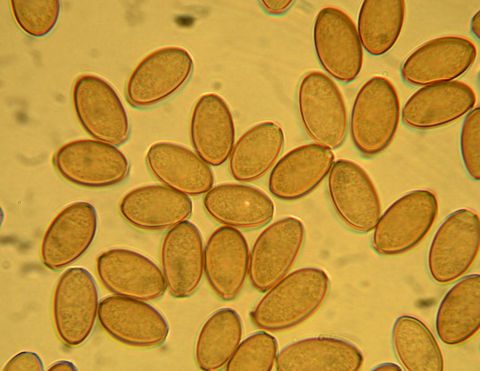

Alternaria is a plant pathogen, and some species are also parasitic on living plants. In fact, statistics show that at least 20% of lost agricultural yields are due to various Alternaria species, and sometimes, these losses can reach up to 80%.
Many species of Alternaria have been known to cause health problems in humans. They produce mycotoxins that affect the respiratory system, skin and nails. Other species are common allergens that may lead to asthma, hay fever, etc., but they rarely cause serious infections. They are of particular risk to immuno-suppressed and wounded individuals.
Potential Health Effects
Allergens
Commonly recognized.
Type I allergies (hay fever, asthma).
Type III hypersensitivity pneumonitis: Woodworker's lung, Apple store hypersensitivity.
May cross react with Ulocladium, Stemphylium, Phoma, others.
Potential Opportunist or Pathogen
Nasal lesions, subcutaneous lesions, nail infections; the majority of infections reported from persons with underlying disease or in those taking immunosuppressive drugs. Most species of Alternaria do not grow at 37°C.
Potential Toxin Production
A. alternata produces the antifungal alternariol. Other metabolites include AME (alternariol monomethylether), tenuazonic acid, and altertoxins (mutagenic).
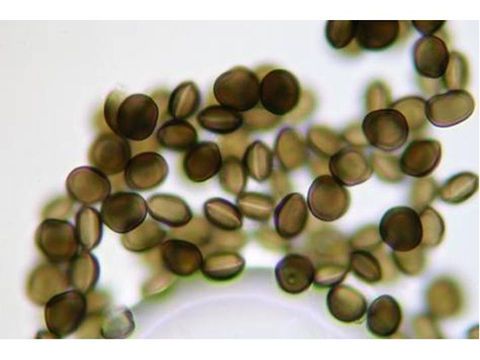
Potential Health Effects
Allergens
One species, Arthrinium sphaerospermum, reported as an allergen.
Potential Opportunist or Pathogen
Not known.
Potential Toxin Production
Not known
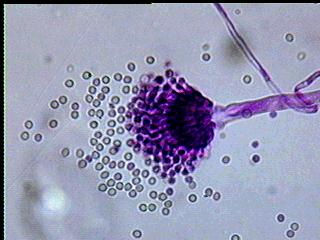
Potential Health Effects
Allergens
Common.
Type I allergies (hay fever, asthma).
Type III hypersensitivity pneumonitis: Humidifier lung, Malt worker's lung, Compost lung, Wood trimmer's disease, Straw hypersensitivity, Farmer's lung, Oat grain hypersensitivity, others.
Other: A. fumigatus: allergic bronchopulmonary aspergillosis (ABPA), allergic fungal sinusitis.
Potential Opportunist or Pathogen
Respiratory, invasive, cutaneous, ear, and corneal disease. Severe, invasive disease is usually associated with immunosuppressed hosts. Many species grow at 37°C (body temperature).
A. fumigatus: fungus ball and invasive disease.
A. flavus: nasal sinus lesions, invasive disease.
A. niger: "Swimmer's ear," and invasive disease.
Potential Toxin Production
Partial list:
A. flavus: aflatoxin B1 & B2, cyclopiazonic acid, kojic acid
A. fumigatus: ergot alkaloids, fumigaclavines, gliotoxin, fumigatoxin, fumigillin, fumitremorgens, helvolic acid, tryptoquivaline tremorgens, verruculogen.
A. niger: malformin C, oxalic acid.
A. ustus: austocystins.
A. versicolor: aspercolorin, averufin, cyclopiazonic acid, sterigmatocystin, versicolorin.
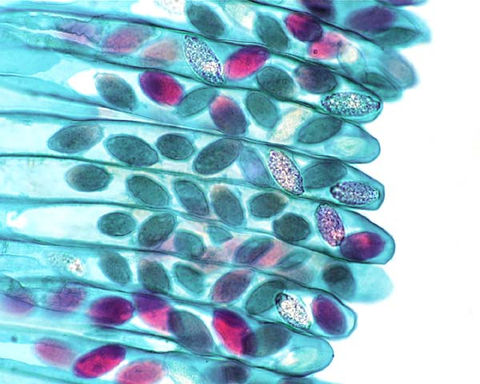
Potential Health Effects
Allergens
Highly variable, dependent on genus and species. Poorly studied.
Potential Opportunist or Pathogen
Dependent on genus and species, but the vast majority do not cause disease.
Potential Toxin Production
Very many, dependent on genus and species.
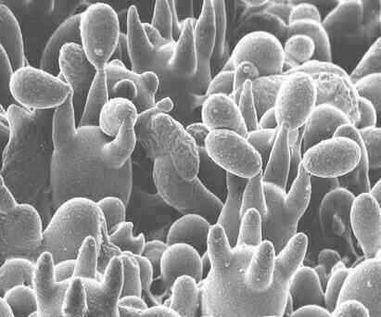
Potential Health Effects
Allergens
Probably common.
Type I allergies (hay fever, asthma).
Type III hypersensitivity pneumonitis: Lycoperdonosis (puffball spores), Mushroom culture hypersensitivity.
Potential Opportunist or Pathogen
Asexual forms may cause rare opportunistic infections.
The yeast Cryptococcus neoformans is a basidiomycete.
Potential Toxin Production
Mushroom toxicosis (poisoning) is usually a result of ingestion of the following toxins: amanitins, monomethyl-hydrazine, muscarine, ibotenic acid, psilocybin

Potential Health Effects
Allergens
Common.
Type I allergies (hay fever, asthma).
Other: Most commonly reported cause of allergic fungal sinusitis.
Potential Opportunist or Pathogen
Occasionally a cause of phaeohyphomycosis, including keratitis, sinusitis, and osteomyelitis. These infections most often occur in immunocompromised persons, although infections also occur in normal hosts. One case of brain abscess reported in an immunocompromised patient.
Potential Toxin Production
Not known.

Potential Health Effects
Allergens
Type I allergies (hay fever, asthma).
Type III hypersensitivity pneumonitis: Winegrower's lung.
Potential Opportunist or Pathogen
Very rare agent of keratomycosis. No recorded human cases of infection.
Potential Toxin Production
None known.

Potential Health Effects
Allergens
Not well studied.
Type I allergies (hay fever, asthma).
Potential Opportunist or Pathogen
Uncommon agent of onychomycosis (nail infection).
Potential Toxin Production
Chaetomin. Chaetomium globosum produces chaetoglobosins. Sterigmatocystin is produced by rare species. Other compounds produced (which may not be mycotoxins in the strict sense) include a variety of mutagens.

Potential Health Effects
Allergens
Common and important allergen.
Type I allergies (hay fever, asthma).
Type III hypersensitivity pneumonitis: Hot tub lung, Moldy wall hypersensitivity.
Potential Opportunist or Pathogen
Generally, non-pathogenic. One species, Cladosporium carrionii, is an agent of chromoblastomycosis in subtropical and tropical regions (grows at 35-37°C).
Potential Toxin Production
Cladosporin, emodin.
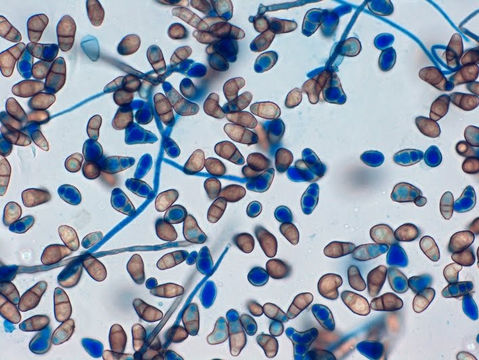
Potential Health Effects
Allergens
Common.
Type I allergies (hay fever, asthma).
Other: A relatively common cause of allergic fungal sinusitis.
Potential Opportunist or Pathogen
Occasionally a cause of onychomycosis, ocular keratitis, sinusitis, mycetoma, pneumonia, endocarditis, cerebral abscess, and disseminated infection. Most cases are from immunocompromised patients.
Potential Toxin Production
Not known.
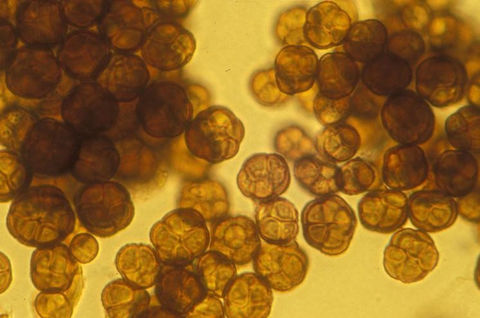
Potential Health Effects
Allergens
Common.
Type I allergies (hay fever, asthma).
Potential Opportunist or Pathogen
No cases of infection have been reported in humans or animals.
Potential Toxin Production
Antibiotic substances produced: flavipin, epicorazine A & B, indole-3-acetonitrile.
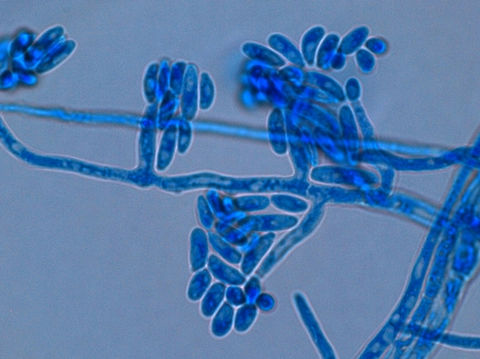
Potential Health Effects
Allergens
Type I allergies (hay fever, asthma).
Potential Opportunist or Pathogen
Causes keratitis, endophthalmitis, onychomycosis, mycetoma, and disseminated infection in immunocompromised patients; infections in burn victims, and systemic opportunistic infections in severely disabled hosts.
Potential Toxin Production
Trichothecenes (type B); T-2 toxin; zearalenone (F-2 toxin), vomitoxin, deoxynivalenol, and fumonisin. Zearalenone is not acutely toxic, and actually may have positive effects with controlled ingestion.
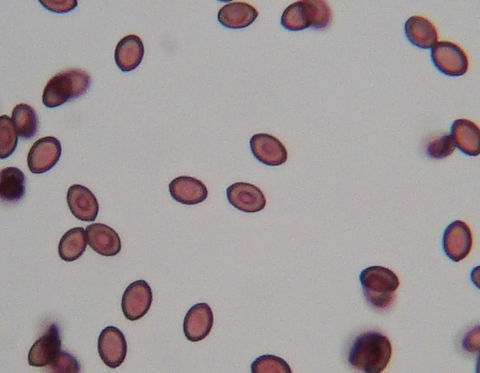
Potential Health Effects
Allergens
Probably common.
Type I allergies (hay fever, asthma).
Type III hypersensitivity pneumonitis: Lycoperdonosis (puffball spores), Mushroom culture hypersensitivity.
Potential Opportunist or Pathogen
Asexual forms may cause rare opportunistic infections.
The yeast Cryptococcus neoformans is a basidiomycete.
Potential Toxin Production
Mushroom toxicosis (poisoning) is usually a result of ingestion of the following toxins: amanitins, monomethyl-hydrazine, muscarine, ibotenic acid, psilocybin

Potential Health Effects
Allergens
Not studied.
Potential Opportunist or Pathogen
Not known.
Potential Toxin Production
Trichothecenes (trichodermol and trichodermin) and griseofulvins. Trichothecene toxicity is due to the ability to bind ribosomal protein. Griseofulvin has been made commercially available as an anti-dermatophyte drug.

Monodictys is a genus of mold that is assigned to the form classification (i.e. based on morphology) of “hyphomycetes”. Hyphomycetes molds lack a closed fruiting body and are anamorphic (having an asexual reproductive stage).
Monodictys sp. are dematiaceous, a term that refers to its colonies’ dark appearance that results from the melanization of its cell walls. Colonies appear dark gray, brown, or black. Even the mycelium of this mold has a dark yellow or brown color. [1]
As of this writing, this genus of mold is not known to be listed in clinical medical references.
In nature, Monodictys sp. are found on twigs, apple trees, oak, seeds, other plants and plant matter (either alive or dead), dung, bones, and soil composites. They are often found growing with the aleuriosporous (i.e. its spores are releasing) form of the fungus Neta quadriguttata.
Also of interest is one species that is lichenicolous (Monodictys anaptychia) [2], meaning it is a parasitic fungus that only lives on lichen as the host.
In the indoor environment, Monodictys sp. have been identified on paper, cloth, and water-damaged wood, so home and building furnishings and some structural components can be at risk when wet or when the indoor humidity is too high.

Potential Health Effects
Allergens
Type I allergies (hay fever, asthma).
(Lycogala used in one skin test survey.)
Potential Opportunist or Pathogen
No reports of human infection.
Potential Toxin Production
None.

Potential Health Effects
Allergens
Type I allergies (hay fever, asthma).
Potential Opportunist or Pathogen
Very rare report of human infection.
Potential Toxin Production
Not known.

Potential Health Effects
Allergens
Type I allergies (hay fever, asthma).
Type III hypersensitivity pneumonitis: Humidifier lung.
Potential Opportunist or Pathogen
Although Paecilomyces grows at 37°C, human disease is relatively rare. Mycotic keratitis in conjunction with corneal implants, nosocomial infections, endocarditis, infections in immunocompromised patients are reported.
Potential Toxin Production
Paecilotoxins, byssochlamic acid, variotin, ferrirubin, viriditoxin, indole-3-acetic acid, fusigen and patulin.

Potential Health Effects
Allergens
Not studied.
Potential Opportunist or Pathogen
No reports of infections.
Potential Toxin Production
Sporidesmin.

Scopulariopsis is a large genus comprising mainly soil species. Species are frequently isolated from food and building materials such as drywall paper and wood. This fungus has relatively high water activity similar to Stachybotrys. Very little is known about the health effects of this fungus. Certain species may be involved in human onychomycoses or pulmonary mycoses. Scopulariopsis has been recovered from culturable air, spore trap, and dust samples. Its Teleomorph, Microascus, has also been recovered from indoor building material.

This organism is rarely found in outdoor samples. Grows well on wet media, preferably containing cellulose. It proliferates in the indoor environment with long term water damage, growing on wallpaper, gypsum board, and textiles. As a general rule, air cultures for Stachybotrys yields unpredictable results, mainly due to the fact that this fungus is usually accompanied by other fungi such as Aspergillus and Penicillium that normally are better aerosolized than Stachybotrys. This is a slow growing fungus on media. It does not compete well with other rapidly growing fungi. The black fungi grow on building material with high cellulose content and low nitrogen content. Appropriate media for the growth of this organism will have high cellulose content and low nitrogen content.
Potential Health Effects
Allergens
Not well studied.
Type I allergies reported.
Potential Opportunist or Pathogen
No reports of human infection. (No species grow well at 37°C.)
Potential Toxin Production
Macrocyclic trichothecenes: verrucarin J, roridin E, satratoxin F, G & H, sporidesmin G, trichoverrol; cyclosporins, stachybotryolactone.
Stachybotrys mycotoxicosis: human toxicosis has been described; may be characterized by dermatitis, cough, rhinitis, itching or burning sensation in mouth, throat, nasal passages and eyes. The best described toxicoses are from domestic animals that have eaten contaminated hay and straw or inhaled infected material from contaminated bedding.

Potential Health Effects
Allergens
Type I allergies (hay fever, asthma).
Potential Opportunist or Pathogen
No reports of human infection.
Potential Toxin Production
Torula herbarum was cytotoxic in screening tests performed by our laboratory. The nature of the toxin(s) is unknown.

Potential Health Effects
Allergens
Major.
Type I allergies (hay fever, asthma).
Ulocladium cross-reacts with Alternaria, adding to the allergenic burden of Alternaria-sensitive patients.
Potential Opportunist or Pathogen
Rare subcutaneous tissue infection.
Potential Toxin Production
Not known.

Zygomycetes are one of the four major groups of fungi, the others being the Oomycetes, the Ascomycetes, and the Basidiomycetes. Zygomycetes are common, fast growing, and often overgrow and/or inhibit other fungi nearby. Rhizopus and Mucor are two of the most common Zygomycetes seen in the indoor environment. However, others are seen as well, including Syncephalastrum, Circinella, Mortierella, Mycotypha, Cunninghamella, and Choanephora. For further information, please see descriptions of these individual genera.
